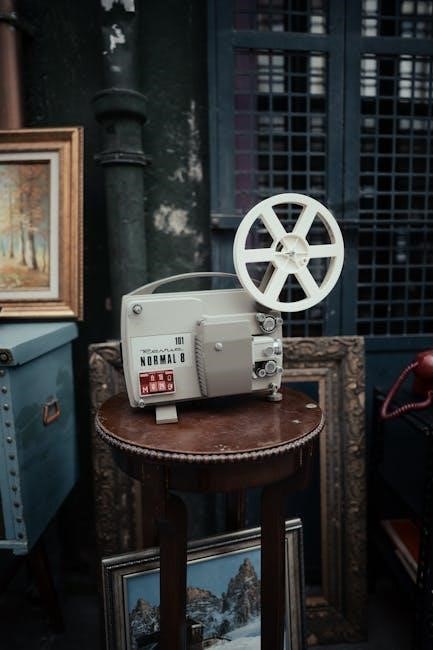Projectors come in various types tailored to specific needs: home theater, business, gaming, and portable models. Each offers unique features like 4K resolution, high brightness, or portability, ensuring optimal performance for movies, presentations, or outdoor use.
1.1 Home Theater Projectors
Home theater projectors are designed for immersive cinematic experiences, offering high resolution, brightness, and color accuracy. Ideal for movie nights, they often support 4K, HDR, and wide color gamut. Models like the Sony VPL-XW5000ES and BenQ HT4550i provide stunning visuals. Consider contrast ratio, aspect ratio, and ambient light control for optimal performance in your viewing space.
1.2 Business and Education Projectors
Business and education projectors are designed for professional settings, offering durability and versatility. They often feature lower resolutions than home theater models but prioritize connectivity and portability. Ideal for classrooms or boardrooms, they support presentations, videos, and interactive content, ensuring engagement for both students and professionals. Look for models with multiple input options and easy setup.
1.3 Gaming Projectors
Gaming projectors are optimized for immersive gaming experiences, offering low input lag, high refresh rates, and vibrant colors. They often support 4K resolution, HDR, and wide color gamut, ensuring sharp visuals. Designed for console and PC compatibility, these models prioritize responsiveness and clarity, making them ideal for competitive and casual gamers seeking a cinematic gaming setup.
1.4 Portable and Outdoor Projectors
Portable and outdoor projectors offer versatility and convenience, ideal for on-the-go use. They are compact, lightweight, and often feature built-in batteries and wireless connectivity. These models are designed for outdoor screenings or travel, with brightness levels suitable for various lighting conditions, ensuring entertainment anywhere without compromising image quality or performance.
Key Specifications to Consider
When selecting a projector, focus on brightness (lumens), resolution, contrast ratio, and projection technology (DLP, LCD, laser). These specs ensure optimal image quality and performance for your needs.
2.1 Brightness and Lumens
Brightness, measured in lumens, is crucial for image clarity. Higher lumens ensure better visibility in lit rooms. For home theaters, 1,500-3,000 lumens suffice, while outdoor or bright spaces may require 3,000+ lumens for vibrant displays.
2.2 Resolution and Aspect Ratio
Resolution, such as 1080p or 4K, determines image sharpness. A higher resolution offers clearer details. Aspect ratio, like 16:9 for widescreen or 4:3 for older content, must match your material for optimal display. Ensuring compatibility ensures an immersive viewing experience tailored to your needs.
2.3 Contrast Ratio and Color Accuracy
Contrast ratio measures the difference between the brightest and darkest images, impacting depth and realism. Higher ratios ensure better clarity in bright or dark scenes. Color accuracy ensures vivid, lifelike hues, crucial for cinematic experiences. Look for projectors with HDR and wide color gamut for enhanced color reproduction and dynamic range.
2.4 Projection Technology (DLP, LCD, Laser)
DLP projectors offer sharp images and vibrant colors, ideal for home theaters. LCD models provide good brightness and color accuracy, suitable for environments with ambient light. Laser projectors deliver long lifespan, consistent brightness, and minimal maintenance, making them a premium choice for both home and professional use.

Understanding Lighting Conditions
Lighting conditions significantly impact projector performance. Ambient light requires higher brightness for clarity. In dark rooms, lower brightness with better contrast is ideal. Balance is key for optimal viewing.
3.1 Ambient Light and Its Impact
Ambient light affects image quality by reducing contrast and washed-out colors. High levels require projectors with higher brightness (measured in lumens) to maintain clarity. Natural light or overhead lighting can degrade the viewing experience, making it essential to choose a projector suited to your room’s lighting conditions for optimal performance and visual fidelity.
3.2 Brightness Requirements for Different Environments
Brightness needs vary by setting: home theaters require 1,000–2,000 lumens for dark rooms, while offices or classrooms need 2,500–4,000 lumens to counter ambient light. Outdoor or daylight environments demand 3,500–5,000 lumens or more for clear visibility. Matching lumen output to your space ensures vibrant, visible images regardless of lighting conditions.
3.3 Screen Size and Viewing Distance
Screen size and viewing distance significantly impact image quality. Larger screens require higher brightness and resolution for clarity. Ensure the projector’s throw distance matches your space. A balanced setup optimizes the viewing experience, with recommended distances varying by screen size to maintain sharpness and color accuracy.
Connectivity and Compatibility
Connectivity and compatibility are crucial for seamless integration with devices. Ensure your projector has HDMI ports, wireless options, and supports gaming consoles, PCs, and streaming devices.
4;1 HDMI and Other Input/Output Ports
HDMI ports are essential for connecting devices like Blu-ray players or consoles. Ensure your projector has multiple HDMI inputs for versatility. Additionally, check for USB ports for media playback and audio ports for external sound systems. Verify compatibility with your devices to avoid connection issues and ensure seamless setup.
4.2 Wireless Connectivity Options
Wireless connectivity enhances convenience, allowing seamless streaming from devices. Look for Wi-Fi and Bluetooth support for connecting smartphones, tablets, or laptops. Chromecast and Miracast enable direct content casting without cables. Ensure compatibility with your devices for a smooth experience. Wireless options reduce clutter and simplify setup, making it ideal for portable or outdoor use.
4.3 Device Compatibility (Gaming Consoles, PCs, Streaming Devices)
Ensure your projector supports your devices, such as gaming consoles, PCs, and streaming devices. Check for HDMI ports and USB connections for wired setups. Wireless options like Chromecast or AirPlay enable direct streaming from smartphones or tablets. Compatibility ensures seamless integration with your existing tech, enhancing versatility for gaming, work, or entertainment.
Sound Quality and Audio Considerations
Projectors often come with built-in speakers, but for immersive sound, consider external systems. Check for support of audio formats like Dolby Atmos and surround sound capabilities for enhanced experiences.
5.1 Built-in Speakers vs. External Sound Systems
Built-in speakers offer convenience but may lack quality for immersive audio. External systems provide superior sound, especially for home theaters or large spaces, ensuring a more engaging experience with better clarity and depth.
5.2 Audio Formats and Surround Sound Support
Ensure your projector supports essential audio formats like Dolby Digital and DTS for enhanced sound quality. Look for surround sound compatibility to create an immersive experience, especially for movies and games, and verify it works seamlessly with your external audio setup or streaming devices.

Portability and Installation
Portable projectors offer convenience for on-the-go use, while installation options vary from fixed setups to ceiling mounts. Throw distance and lens adjustments are key considerations for optimal image quality in any setting.
6.1 Portable Projectors for On-the-Go Use
Portable projectors are perfect for travel or outdoor use, offering compact designs, lightweight builds, and often battery-powered operation. Many models include wireless connectivity, making them ideal for presentations, camping trips, or backyard movie nights without compromising on image quality or convenience.
6.2 Fixed vs. Ceiling-Mounted Installations
Fixed projectors are ideal for permanent setups, offering stability and optimal image quality, while ceiling-mounted models save space and reduce clutter. Both options require precise installation but provide a professional setup for home theaters or classrooms, enhancing the viewing experience with minimal distractions and a clean aesthetic.
6.3 Throw Distance and Lens Adjustments
Throw distance and lens adjustments are crucial for optimal image quality. Ensuring the projector is correctly positioned relative to the screen size prevents distortion. Adjustments like zoom and focus fine-tune the image, while lens shift enables flexibility in installation. Proper setup guarantees a sharp, clear picture, maximizing your viewing experience across various environments and screen sizes.

Budget and Price Considerations
Set a budget and compare models within your range. Entry-level projectors offer affordability, while high-end models provide advanced features. Consider long-term costs like lamp replacement for optimal value.
7.1 Entry-Level vs. High-End Projectors
Entry-level projectors are budget-friendly, offering basic features for casual use, with lower brightness and resolution. High-end models provide advanced specs like 4K, HDR, and higher brightness, ideal for cinematic experiences. Choose based on your needs and budget to ensure the best value for your investment in home or professional settings.
7.2 Cost of Ownership (Lamp Replacement, Maintenance)
Consider long-term costs like lamp replacements, which can range from $50 to $500, and maintenance. LED and laser projectors often have longer lifespans, reducing replacement needs. Energy efficiency also impacts running costs. Check manufacturer estimates for lamp life and power consumption to understand total ownership expenses over time.
7.3 Value for Money and Long-Term Investment
Evaluate projectors by balancing cost with performance and features. A higher initial price may offer long-term savings through energy efficiency or durability. Consider models like Sony VPL-XW5000ES for 4K quality or BenQ HT4550i for vivid colors. Prioritize future-proofing with technologies like HDR or laser light sources to enjoy extended usability and satisfaction over time.

Advanced Features to Look For
Look for cutting-edge technologies like 4K resolution, HDR support, and high refresh rates for smooth motion. Smart projectors with app integration and voice control enhance convenience, while laser technology offers superior brightness and longevity for an immersive viewing experience.
8.1 4K and 8K Resolution Support
4K and 8K resolution support in projectors delivers stunning visuals with exceptional clarity. These resolutions are ideal for home theaters, offering vibrant images. For gaming and cinematic experiences, higher resolutions provide immersive details. Ensure compatibility with your content sources to maximize the benefits of these advanced displays.
8.2 HDR and Wide Color Gamut
High Dynamic Range (HDR) and Wide Color Gamut enhance image quality by delivering richer colors and deeper contrasts. HDR formats like HDR10 and HLG provide vivid details in bright and dark scenes. A wide color gamut ensures lifelike hues, making HDR projectors ideal for home theaters and gaming, offering cinematic experiences with stunning visual fidelity.
8.3 Motion Handling and Refresh Rate
Motion handling and refresh rate are crucial for smooth visuals. Higher refresh rates reduce motion blur, ideal for gaming and fast-paced content. Look for projectors with high Hz ratings and technologies like motion interpolation to enhance clarity and fluidity, ensuring immersive experiences in movies, sports, and games without distracting artifacts.
8.4 Smart Projector Features and App Integration
Smart projectors offer integrated apps and wireless connectivity, enabling seamless streaming from platforms like Netflix and Disney+. Voice control via smart assistants enhances convenience. Ensure the projector supports your preferred services and devices for a hassle-free, connected entertainment or presentation experience, making setup and use more intuitive and user-friendly.

Environmental and Practical Considerations
Consider noise levels, energy efficiency, and durability. Consider energy-efficient models with lower power consumption and quieter operation for long-term savings and reduced environmental impact.
9;1 Noise Levels and Fan Operation
Noise levels and fan operation are crucial for immersive experiences. Look for projectors with low decibel ratings (typically below 30dB) to minimize distractions. Advanced cooling systems and silent motors reduce fan noise, ensuring quieter operation during movies or presentations. Opt for models with eco-modes or laser technology for even quieter performance.
9.2 Energy Efficiency and Power Consumption
Energy efficiency and power consumption are key considerations for long-term savings. LED and laser projectors typically consume less power than traditional models. Look for Energy Star certification and eco-mode features, which reduce energy use without compromising performance. Lower wattage and advanced technologies ensure both cost-effectiveness and environmental friendliness for your projector setup.
9.3 Durability and Build Quality
Durability and build quality are essential for long-term reliability. Look for projectors with metal bodies and sturdy construction. Components like lamps and DMD chips should have extended lifespans. A reliable cooling system prevents overheating, ensuring consistent performance. Durable projectors offer better value, withstanding regular use and maintaining optimal functionality over time.

Buying Tips and Tricks
Research thoroughly, read reviews, and compare models. Ensure the projector’s specs match your needs. Check warranties and support options. Avoid common mistakes by prioritizing your usage scenario and budget.
10.1 Reading Reviews and Comparisons
Reading reviews and comparisons is crucial when selecting a projector. Look for insights on brightness, resolution, and color accuracy. Pay attention to user experiences and expert opinions to gauge reliability and performance. This helps narrow down options and ensures the projector meets your specific needs and expectations for home, office, or outdoor use effectively.
10.2 Checking Warranty and Support Options
When purchasing a projector, ensure to check the warranty and support options. A comprehensive warranty covers repairs and replacements, while reliable customer support provides assistance. Look for brands offering extended warranties, dedicated service hotlines, and online resources. This ensures long-term protection and peace of mind for your investment in home or professional use.
10.3 Avoiding Common Mistakes in Projector Selection
Avoid common mistakes like ignoring room lighting conditions, overlooking screen size, or neglecting connectivity needs. Ensure the projector’s brightness matches ambient light levels and verify compatibility with your devices. Also, don’t forget to check refresh rates for gaming or motion handling for smooth video playback, and avoid models with limited future-proofing features.
Selecting the right projector involves understanding your needs, environment, and budget; By considering key factors like brightness, resolution, and connectivity, you’ll find a projector that enhances your viewing experience.
11.1 Final Checklist for Your Projector Purchase
Before finalizing, ensure your projector meets your primary use case, has sufficient brightness for lighting conditions, and the desired resolution. Check connectivity options, audio quality, and portability needs. Compare budget with features to ensure value. Read reviews, verify warranty, and ensure compatibility with your devices for a seamless experience.
11.2 Making the Most of Your Projector Experience
To maximize your projector’s potential, optimize your viewing environment by controlling ambient light and ensuring proper screen placement. Regularly clean the lens and update firmware for optimal performance. Experiment with settings like color calibration and sound enhancements to enhance image and audio quality, ensuring an immersive experience tailored to your preferences and setup.

